E2W sales jump 33% to 1.14 million units and 59% of India EV market in CY2024
Sustained demand for wallet- and eco-friendly electric mobility on two wheels, from both personal users and fleet buyers, along with much-increased new product availability saw the segment achieve a new high. The top five OEMs – Ola Electric, TVS, Bajaj Auto, Ather Energy and Greaves Electric Mobility – clocked their best-ever annual sales even as demand grew for electric motorcycle makers like Revolt.
If India’s electric vehicle (EV) industry came within a whisker of achieving a record 2 million (20 lakh) retail sales in CY2024, then it is because of the big volumes provided by the most affordable sub-segment – electric two-wheelers. Of the the total 1.94 million EVs sold across vehicle segments in India in 2024 (up 27% YoY), electric scooters and motorcycles accounted for 1.14 million units (11,48,415) or 59% – up from the 56% share of 2023 – recording strong double-digit growth of 33% (CY2023: 860,418 units, up 36% YoY).
 Other than the last month of the year, retail sales of electric scooters and motorcycles maintained their strong double-digit growth throughout CY2024.
Other than the last month of the year, retail sales of electric scooters and motorcycles maintained their strong double-digit growth throughout CY2024.
While the initial cost of an electric two-wheeler typically remains higher than its petrol-engine sibling (even though some OEMs have rolled out affordable models in 2024), what is enabling the transition from ICE to EV is the promise of wallet-friendliness in the long term. Petrol prices (Rs 103.49 a litre on December 31 in Mumbai) have remained more or less unchanged since May 2022.
Along with demand for personal mobility, e-two-wheeler manufacturers are also benefiting from sustained demand for last-mile deliveries from urban India as well as town and country, which is acting as a sales catalyst for e-two-wheelers deployed for e-commerce and food deliveries. This is thanks to the key advantage stemming from TCO (Total Cost of Ownership), particularly for fleet operators who clock plenty of kilometres each day. Like the aircraft industry, e-vehicles used for fleet operations make money the more they are on the road. It’s a plug-in-plug-out seamless operation for them – while 50% of the fleet would be out on the job, the other half is getting charged, ready to replace their parched brethren when they come in for their ‘juice’ of electricity.
In a field comprising 220 players – up from 180 in CY2023 – there are four OEMs which have had the giant’s share of the market in 2024. Ola Electric, TVS Motor Co, Bajaj Auto and Ather Energy have all registered six-figure sales and also their own individual best-ever annual performances. The combined sales of this quartet add up to 947,623 units, which constitutes 82% of India’s total e-two-wheeler sales. Interestingly, other than Bajaj Auto – which Autocar Professional correctly forecast a year ago that it was the dark horse for all 2024 – all three OEMs have their manufacturing plants in Tamil Nadu.
Meanwhile, Hero MotoCorp, Greaves Electric Mobility, Revolt Motors, Bgauss Auto and Kinetic Green are also making their presence felt in the sector. Here’s taking a closer look at the top six OEMs who were the movers and shakers of the Indian e-two-wheeler industry in CY2024.
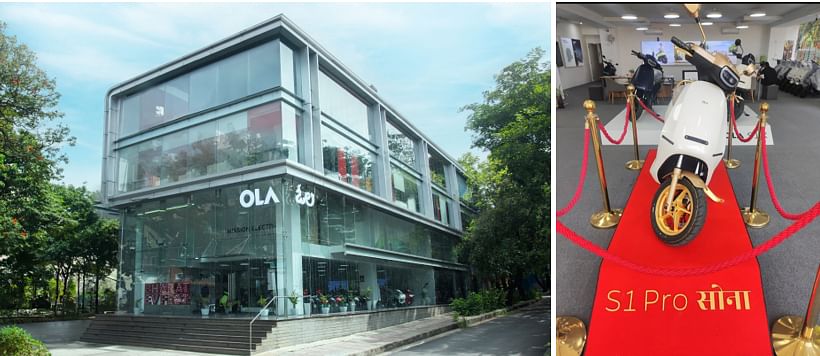 OLA ELECTRIC
OLA ELECTRIC
CY2024: 407,547 units, up 52% YoY / Market share: 35%
CY2023: 267,376 units, up 143% / Market share: 31% Market leader Ola Electric wrapped up 2024 with its best-ever annual retail sales of 407,547 units, up 52% YoY. On December 15, Autocar Professional broke the news of Ola being the first EV maker to sell over 400,000 units in a calendar year. Its 2024 count could have been much higher had it maintained the same growth trajectory it displayed in the first half of the year. Quarter on quarter, sales kept dropping. While Q1 CY2024 saw sales of 120,130 units, Q2 (108,407 units), Q3 (94,171 units) and Q4 (84,838 units) were all lower than Q1 (see Ola’s 12-month sales data above).
Market leader Ola Electric wrapped up 2024 with its best-ever annual retail sales of 407,547 units, up 52% YoY. On December 15, Autocar Professional broke the news of Ola being the first EV maker to sell over 400,000 units in a calendar year. Its 2024 count could have been much higher had it maintained the same growth trajectory it displayed in the first half of the year. Quarter on quarter, sales kept dropping. While Q1 CY2024 saw sales of 120,130 units, Q2 (108,407 units), Q3 (94,171 units) and Q4 (84,838 units) were all lower than Q1 (see Ola’s 12-month sales data above).
Ola Electric’s current mass-market S1 X portfolio is available in three battery configurations (2 kWh, 3 kWh, and 4 kWh), and priced at Rs 69,999, Rs 84,999, and Rs 99,999, respectively (ex-showroom Delhi). The company has also recently revised the prices of its S1 Pro, S1 Air, and S1 X+ to Rs 129,999, Rs 1,04,999, and Rs 89,999, respectively.
Nevertheless, expect Ola to up the ante in CY2025 when it starts delivering the new products – the S1 Z priced at Rs 59,999 and the S1 Z+ which costs Rs 64,999 and the Ola Gig, a dedicated product for the gig economy, priced at an extremely affordable Rs 39,999, it launched in end-November. Deliveries of the S1 Z, S1 Z+, Gig and Gig1 are slated to begin only next year, around April-May.
Meanwhile, on Christmas Day 2024, Ola announced that it had expanded its network to all of 4,000 stores across India. With 3,200 new stores co-located with service centres, this expansion will make Ola’s EVs more accessible across metros, Tier-2, and Tier-3 cities.
Ola had opened CY2024 with 32,424 units (up 77%) in January, hit a high of 53,640 units in March (up 150%) and maintained stellar month-on-month growth right from April through to July until the sharp drop in August and September. Ola’s sales decline in August and September were attributed to be related to a large number of customer complaints about service deficiencies. However, following the recently listed company’s assurance that it had addressed 99.1% of the complaints to the satisfaction of its customers through its redressal mechanism, sales saw a strong revival in festive October to 41,775 units (up 75%). But November and December saw demand down again.
In terms of market share, Ola, which had hit a low of 27% in September – down by 11 percentage points from the 38% it commanded in March 2024 and July 2024 – regained some momentum in October with 30% but dropped to 24.54% in November. Cumulative 12-month sales-wise, Ola remains a yawning distance ahead of the competition. Its CY2024 sales (407,547 units, up 52% YoY) give it an overall market share of 35%, up from 31% in the year-ago period.
 TVS MOTOR CO
TVS MOTOR CO
CY2024: 220,472 units, up 32% YoY / Market share: 19%
CY2023: 166,580 units, up 252% / Market share: 19% TVS Motor Co retains its No. 2 position in CY2024 with total retails of 220,472 iQubes, marking the first time that it has surpassed the 200,000-units sales milestone in a year. This constitutes a 32% YoY increase (CY2023: 166,580 units, up 252%) and translates into an additional 53,892 units sold, thereby ensuring that it kept a hard-charging Bajaj Auto at bay. The festival month of October 2024, which saw 30,180 iQubes being bought, was the best one for TVS in 2024, followed by the FY2024-ending March (26,644 units).
TVS Motor Co retains its No. 2 position in CY2024 with total retails of 220,472 iQubes, marking the first time that it has surpassed the 200,000-units sales milestone in a year. This constitutes a 32% YoY increase (CY2023: 166,580 units, up 252%) and translates into an additional 53,892 units sold, thereby ensuring that it kept a hard-charging Bajaj Auto at bay. The festival month of October 2024, which saw 30,180 iQubes being bought, was the best one for TVS in 2024, followed by the FY2024-ending March (26,644 units).
With this performance, TVS and the iQube have a market share of 19% in CY2024 – the same as in CY2023. The TVS iQube is available with three battery options – 2.2 kWh, 3.4 kWh and 5.1 kWh. The base variant (2.2kWh), with 75km real-world range and a charging time of 2 hours, 45 minutes from 0-80% with a 950W charger, is the most affordable iQube at Rs 84,999 (ex-showroom Mumbai). This model along with the 3.4 kWh iQube (Rs 119,000 and 100km range) get a 5-inch TFT display with tow and theft alerts and turn-by-turn navigation.
The iQube ST line-up has two variants with 3.4kWh (Rs 138,500) and 5.1kWh (Rs 185,400). While the ST 3.4 variant has a claimed real-world range of 100km, the range-topping ST 5.1 variant has the largest battery capacity of any Indian electric scooter and a real-world range of 150km on a single charge. The iQube ST 5.1 also has a higher 82kph top speed, and the claimed charging time is 4 hours and 18 minutes from 0 to 80 percent.
The company, which has ample manufacturing capacity on hand, is strategically expanding the iQube dealer network. Currently estimated at around 750 touchpoints across India, TVS is increasing the network each month. The company, which expects two-wheeler EV sales in India to reach 30% market penetration by CY2025, plans to roll out a new electric scooter before the end of FY2025.
It will be among the moves that TVS, which the longstanding No. 2 OEM in this segment and currently engaged in a fierce battle with Bajaj Auto, to protect its turf. In CY2023, TVS had sold a total of 166,580 iQubes – 94,639 units more than Bajaj Auto’s 71,941 Chetaks. That huge gap is now stands sizeably reduced in CY2024 to 27,033 units. And Bajaj Auto had gone ahead of TVS in two of the past 12 months – September and December. The battle will continue in CY2025.
 BAJAJ AUTO
BAJAJ AUTO
CY2024: 193,439 units, up 169% YoY / Market share: 17%
CY2023: 71,941 units, up 235% / Market share: 8% Bajaj Auto, with best-ever annual retail sales of 193,439 Chetaks and 169% YoY growth (CY2023: 71,941 units), unseated CY2023’s No. 3 OEM Ather Energy to take the third rank on the podium. The company not only outsold Ather in each of the past 12 months but has come within biting range of TVS, ending CY2024 27,033 units short of its legacy rival.
Bajaj Auto, with best-ever annual retail sales of 193,439 Chetaks and 169% YoY growth (CY2023: 71,941 units), unseated CY2023’s No. 3 OEM Ather Energy to take the third rank on the podium. The company not only outsold Ather in each of the past 12 months but has come within biting range of TVS, ending CY2024 27,033 units short of its legacy rival.
Like TVS, Bajaj also dispatched a record 28,360 Chetaks to its dealers in October, its best month yet. The company’s rapid rate of growth can be seen in the fact that in CY2024, an additional 121,498 Chetaks were sold compared to CY2023. This is amply reflected in its market share which has more than doubled to 17% from 8% a year ago.
On December 20, Bajaj Auto expanded its Chetak model portfolio with the launch of the new 35 Series which comprises three variants: 3501 (Rs 127,000), 3502 (Rs 120,000) and 3503. The top-spec 3501 variant has a touchscreen TFT console with smartphone connectivity, Google Maps navigation, document storage, and safety features like geofencing. The 3501 is the only variant which gets a key-fob and a lockable glovebox in front. The 3502 has similar features and a TFT albeit it isn't a touchscreen unit and borrowed from the outgoing top-spec Chetak 3201. The 3502 and 3503 miss out on a lockable glovebox and get two open cubbies. Additionally, the 3503 also misses out on a front disc brake and gets drum brakes at both ends.
The battle between Bajaj Auto and TVS has turned intense. Compared to CY2023, Bajaj Auto sold an additional 121,498 Chetaks while TVS sold an additional 53,892 units. Both the TVS iQube and Bajaj Chetak were launched in January 2020. While the TVS iQube has clocked cumulative retails of 439,726 units over the 60 months since launch, the Bajaj Chetak has sold a total of 296,574 units, of which 65% have come in CY2024 itself.
Bajaj Auto’s speedy rate of growth is helping it to close the gap annually with TVS, which is the longstanding No. 2 OEM. This is a result of strong consumer demand for the Chetak, ramped-up production and an expanded Chetak retail sales network. Clearly, the last is not heard on the fierce battle between these OEMs for e-scooter supremacy.
In CY2025, like Ola which is targeted the gig-worker market with its affordable Gig e-scooter, Bajaj Auto has plans to introduce specially designed EVs for gig workers. "Gig workers don't want a vehicle that shows them as gig workers – they want a family vehicle. We will have Chetak models which will be used for delivery but they will be designed recognising the fact that gig workers need a family vehicle," said Rakesh Sharma, executive director, Bajaj Auto, at a round table in Pune after the unveiling of the Chetak 35 series.
 ATHER ENERGY
ATHER ENERGY
CY2024: 126,165 units, up 20% YoY / Market share: 11%
CY2023: 104,736 units, up 101% / Market share: 12%
 Smart e-scooter maker Ather Energy, ranked No. 4, completes the quartet of OEMs to sell over 100,000 units in CY2024. Like Ola, TVS and Bajaj, Ather too achieved its best-ever annual sales last year. The company, whose best month was March 2024 (17,429 units), saw sales decline sharply in May and June but returned to five-figure retails from June onwards (see retail sales data above).
Smart e-scooter maker Ather Energy, ranked No. 4, completes the quartet of OEMs to sell over 100,000 units in CY2024. Like Ola, TVS and Bajaj, Ather too achieved its best-ever annual sales last year. The company, whose best month was March 2024 (17,429 units), saw sales decline sharply in May and June but returned to five-figure retails from June onwards (see retail sales data above).
Cumulative January-December 2024 sales at 126,165 units are up 20% YoY (CY2023: 104,736 units, up 101%), which give Ather a market share of 11% of e2W Inc’s total retails units, down one percent from the 12% market share Ather had in CY2023.
The Rizta family e-scooter (pictured above left) launched in April at a starting price of Rs 109,999 (Rizta S) through to Rs 149,999 (Rizta Z) is witnessing growing customer acceptance. While the S version (2.9 kWh battery) has a 123km range, the Z variant (3.7 kWh) has a 160km range. The Rizta’s highlights include the largest two-wheeler seat in India and storage space aplenty. The Ather Rizta recently bagged Autocar India’s Electric Two-Wheeler of the Year 2025 award.
In an effort to rev up demand for its products, Ather is undertaking new customer-friendly initiatives. In October, it launched Ather Care Service plans which offer free periodic maintenance, discounts on wear-and-tear part replacements, and value-added services such as ExpressCare and polishing.
On November 22, Ather Energy introduced ‘Eight70 Warranty’ for its 450 series and Rizta e-scooters, in collaboration with Reliance General Insurance. This addresses customers’ concerns regarding long-term battery health, performance and replacement costs by providing a host of benefits including coverage for up to 8 years or 80,000km, 70% battery health assurance, full coverage against manufacturing defects and failures; no upper limit on claim amounts, and no claim rejection due to deep discharge of battery cells when the scooter is left uncharged or in an idle state over an extended period of time. According to Ather’s Chief Business Officer Ravneet Singh Phokela, “Battery durability is a crucial factor for EV buyers. We often hear about customers' apprehensions regarding the longevity and replacement costs of the batteries of their electric scooters. Understanding this concern, we have introduced our new Eight70 Warranty, which will eliminate any worries and concerns EV buyers may have regarding the long-term health of their scooter batteries.”
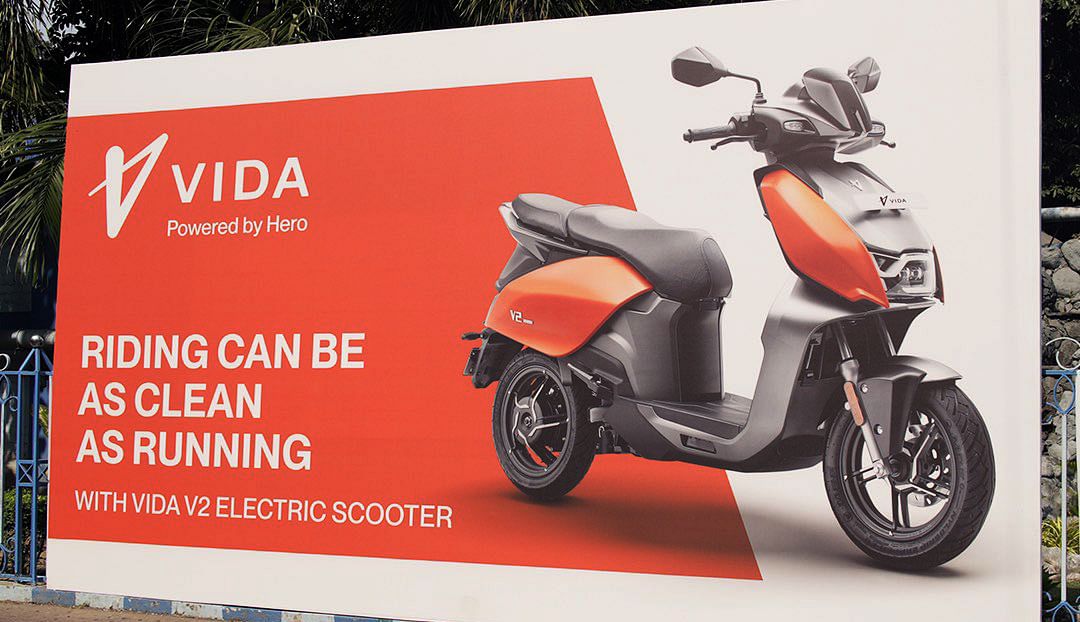 HERO MOTOCORP
HERO MOTOCORP
CY2024: 43,693 units, up 292% YoY / Market share: 4%
CY2023: 11,141 units, up 101% / Market share: 1%
Hero MotoCorp, which is set to enter the electric motorcycle segment next year with a jointly developed midsize performance e-motorcycle with Zero Motorcycles of the USA, registered a near-three-fold YoY increase in its sales of Vida e-scooters in CY2024. At 43,693 units, this marks a 292% YoY increase, albeit on a low year-ago base (CY2023: 11,141 units). October (7,350 units) and November (7,344 units) were the best moths for Vida EV retails in 2024. The much-improved performance is reflected in Hero MotoCorp’s growing market share, which has risen to 4% from 1% in 2023.
Hero MotoCorp has started scaling up brand presence for Vida and its network now stands at 203 touchpoints comprising 180 dealers across 116 cities. The company, which has the V1 Plus and V1 Pro EVs, plans to expand its portfolio – within the mid- and affordable segment – within FY2025. And it already has around 2,500 charging stations in collaboration with Ather Energy, in which Hero MotoCorp is an early investor.
Like all the leading EV OEMs, Hero MotoCorp too is focusing on reducing product cost. In an earnings conference call in mid-August 2024, Niranjan Gupta, CEO, Hero MotoCorp had said: “We are working very aggressively, and on the powertrain side, to bring the costs down by technological improvements, by localization, obviously, by bringing scale. You will see that benefit coming out into our further launches as well. You'll see affordable products coming out later this year.”
That came in early December when Hero MotoCorp expanded its EV portfolio with the launch of the new Vida V2. The Vida 2 is essentially an evolution of the V1 range that the world’s largest ICE two-wheeler began its electric mobility journey in October 2022. The Vida V2 is available in three variants: Lite (Rs 96,000), Plus (Rs 115,000) and Pro (Rs 135,000). The most affordable V2 Lite is an entirely new variant and comes with a small 2.2kWh battery pack that has a claimed 94km IDC range. It also has a lower 69kph top speed compared to the Plus and Pro variants, which have top speeds of 85kph and 90kph, respectively. Only two riding modes are available on the V2 Lite – Ride and Eco – but the rest of the feature-set is very similar to the other two, including the 7-inch touchscreen TFT display.
 GREAVES ELECTRIC MOBILITY
GREAVES ELECTRIC MOBILITY
CY2024: 35,058 units, up 46% YoY / Market share: 3%
CY2023: 24,042 units, up 45% / Market share: 2.79% Greaves Electric Mobility (GEM), which currently has a six-model portfolio of e-scooters comprising the Nexus (pictured above), Primus, Magnus LT/EX (100km+ range), Ampere Magnus Special, entry level Rio Li/La Plus and Zeal EX, has registered its best-ever annual sales in CY2024: 35,058 units, up 46% YoY (CY2023: 24,042 units. This performance gives it a market share of 3.05%, slightly higher than the 2.79% it had in CY2023.
Greaves Electric Mobility (GEM), which currently has a six-model portfolio of e-scooters comprising the Nexus (pictured above), Primus, Magnus LT/EX (100km+ range), Ampere Magnus Special, entry level Rio Li/La Plus and Zeal EX, has registered its best-ever annual sales in CY2024: 35,058 units, up 46% YoY (CY2023: 24,042 units. This performance gives it a market share of 3.05%, slightly higher than the 2.79% it had in CY2023.
GEM’s newest product – the Ampere Nexus launched in end-April – seems to be the key driver of this growth, which has been confirmed by the management. In an investor conference call on November 7, 2024, K Vijaya Kumar, Executive Director and CEO, Greaves Cotton said: “We are registering very robust growth month-on-month, quarter-on-quarter primarily based on our new product. The Nexus, which we launched two quarters before is doing very well.”
Targeted at families, the Ampere Nexus has been designed and developed in-house at the Ranipet facility in Tamil Nadu. Equipped with a 3 kWH LFP battery, the Nexus has a claimed top speed of 93kph and a certified range of 136km. Sold in two variants, prices start at Rs 110,000 (ex-showroom) and go up to Rs 120,000.
GEM’s parent company Greaves Cotton, which has embarked on a strategic growth mission, is seeing GEM, its electric mobility division, deliver impressive results, generating revenues of Rs 175 crore in Q2 FY2025 and Rs 302 crore in H1 FY2025. This growth has been enabled by a focused approach on new product launches and a defined path toward profitability. GEM’s current e-two-wheeler sales and service network across India includes over 400 sales and service points.
Greaves Cotton, which also has a presence in the electric three-wheeler market under the Ele, Greaves and Electra brands, is looking to up the ante in the EV world. The company has announced plans to list its EV arm – Greaves Electric Mobility – in CY2025. The aim is to raise Rs 1,000 crore through a fresh issue of shares. Around Rs 83 crore will be invested in setting up an in-house battery pack assembly plant at its Ranipet plant in Tamil Nadu, which went on stream in November 2021.
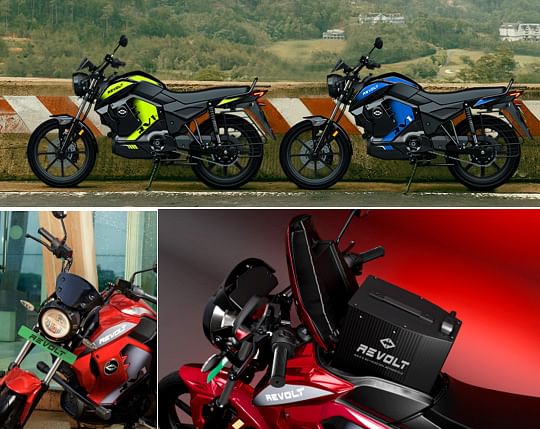
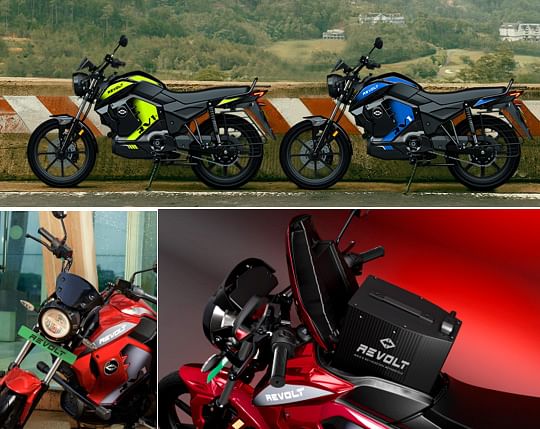 REVOLT MOTORS
REVOLT MOTORS
CY2024: 9,951 units, up 43% YoY / Market share: 0.86%
CY2023: 6,977 units, down 53% YoY / Market share: 0.81% One of the standout sales stories of CY2024 – and a revival of sorts for the company – has been the performance of Revolt Intellicorp (Revolt Motors), one of the few electric motorcycle manufacturers in India. The company, which earlier had only the 4.1kW RV400 priced at Rs 116,800 (on-road Mumbai) and the RV400 BRZ, has expanded its portfolio with the launch of the RV1 and RV1+ ‘commuter’ electric motorcycles, priced at Rs 84,990 and Rs 99,990 respectively in october. The RV1 comes with two battery options – 2.2 kWh battery offering up to 100km range, and a 3.24 kWh battery with 160km range.
One of the standout sales stories of CY2024 – and a revival of sorts for the company – has been the performance of Revolt Intellicorp (Revolt Motors), one of the few electric motorcycle manufacturers in India. The company, which earlier had only the 4.1kW RV400 priced at Rs 116,800 (on-road Mumbai) and the RV400 BRZ, has expanded its portfolio with the launch of the RV1 and RV1+ ‘commuter’ electric motorcycles, priced at Rs 84,990 and Rs 99,990 respectively in october. The RV1 comes with two battery options – 2.2 kWh battery offering up to 100km range, and a 3.24 kWh battery with 160km range.
Revolt Motors has been aggressively expanding its dealership network across India, which now stands at 168 including 14 new ones in cities such as Hubli (Karnataka), Muzaffarpur (Bihar), Katihar (Bihar), Maheshkhunt (Bihar), Khagaria (Bihar), Nawanshahr (Punjab), Kannauj (UP), Satara (Maharashtra), Sattur (Tamil Nadu), Mayiladuthurai (Tamil Nadu), Bhilwara (Rajasthan), Warangal (Telangana), Balasore (Odhisa), and Bulandshahr (Uttar Pradesh).
The new RV1 and RV1+ along with the expanded network seem to have accelerated sales. Revolt’s CY2024 retails at 9,951 units are a robust 43% YoY increase (CY2023: 6,977 units) which translates into an additional 2,974 bikes sold last year. What’s more, the company, which was ranked 14th in CY2023 has risen four ranks to No. 10 position in CY2024. It may be recollected that Revolt’s best annual sales came in CY2022 when it had sold 14,910 units and had a 2.36% market share of the 631,397 electric two-wheelers sold that year.
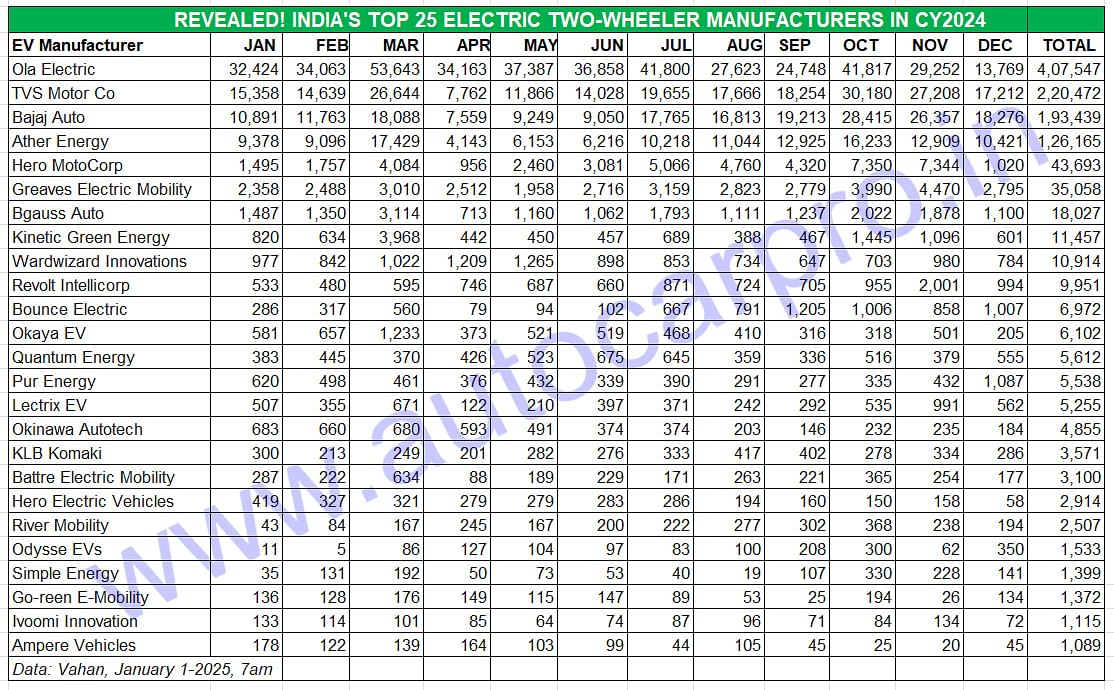
AS HONDA CHECKS IN . . . CY2025 BIDS FAIR TO BE AN EXCITING YEAR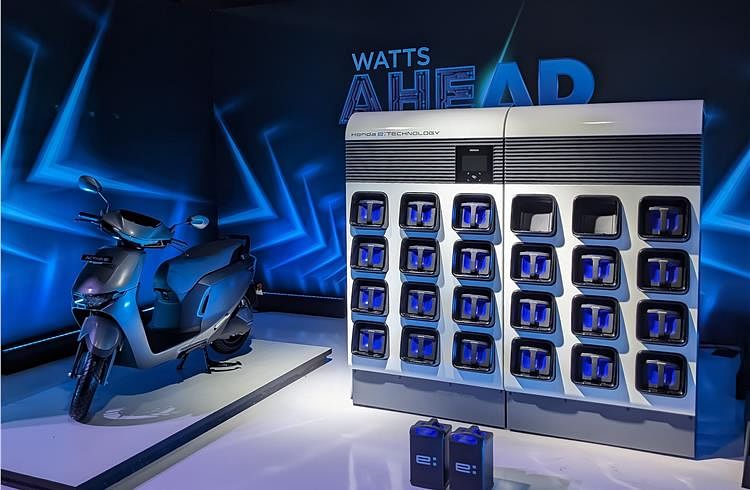 Watt lies ahead for the Indian e2W industry? Honda is the latest ICE legacy OEM and the first Japanese two-wheeler major to plug into electric avenue.
Watt lies ahead for the Indian e2W industry? Honda is the latest ICE legacy OEM and the first Japanese two-wheeler major to plug into electric avenue.
The Indian electric two-wheeler industry will be looking forward to a new year with much optimism even though the subsidy levels have been watered down. Most of the leading OEMs like Ola, TVS, Bajaj Auto, Ather Energy and Greaves Electric Mobility have outlined plans to launch new products this year. This, along with the increased coverage of EV charging infrastructure, both private and public, will act as a catalyst for growth in CY2024.
These top five players though have brand-new competition coming their way in the form of the Honda Activa e and QC1 revealed on November 27, which mark the Japanese OEM’s entry into the Indian electric two-wheeler market. While Honda has not yet revealed the prices of the two EVs, considering that it has already achieved 99% localisation, one can expect the company to come up with disruptive pricing to unsettle the competition.
All the top six OEMs – Ola (which has launched the S1 Z and Gig), TVS, Bajaj Auto, Ather Energy, Hero MotoCorp and Greaves Electric Mobility – are aggressively working to come with up ‘affordable’ or lower priced EVs, more so in the wake of consistently reducing subsidies. Clearly, there’s plenty of exciting new product action to be expected in CY2025. So, stay plugged in to Autocar Professional’s sales analyses for in-depth number-crunching.
ALSO READ:
Bajaj Chetak becomes India’s No. 1 e2W OEM in December
Revolt Motors sells nearly 10,000 electric motorcycles in CY2024
RELATED ARTICLES
Mahindra & Mahindra sells 152,067 SUVs in Q1 FY2026, races past 300,000 in first-half CY2025
M&M, which is riding a wave of surging demand for its SUVs, registers strong 22% growth in April-June 2025 which is its ...
Tata Motors sells 123,839 cars and SUVs in Q1 FY2026, EV sales pick up for second straight month
Tata Motors’ first-quarter FY2026 performance is dragged down by June 2025’s 37,083 passenger vehicle sales, the lowest ...
TVS Motor is No. 1 electric 2W OEM for three months in a row and Q1 FY2026
TVS sells 25,274 iQube e-scooters in the Indian e2W industry's best-ever June and nearly 70,000 units in April-June 2025...





 01 Jan 2025
01 Jan 2025
 52138 Views
52138 Views





 Ajit Dalvi
Ajit Dalvi


 Autocar Professional Bureau
Autocar Professional Bureau


